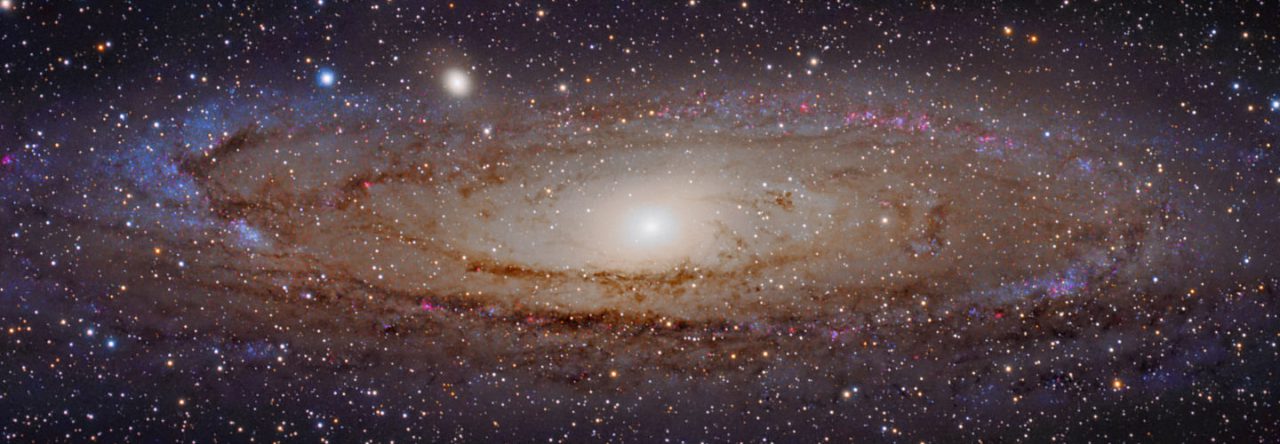
Bringing Astronomy Down to Earth

The astronomy staff at CCSU is dedicated to public outreach. In addition to the important work done in the planetarium, under the leadership Planetarium Director Carol Ivers, all members give talks to the general public at libraries, living facilities, schools, and more. Recently Dr. Kristine Larsen was the featured speaker at a meeting of the New Britain Lions Club. The topic was the successes of the James Webb Space telescope (so far!). If your group is in the Central Connecticut area and would like a free planetarium show or even a guest lecture, please contact us through the Astronomy@CCSU website.
Astronomy and Popular Culture: The Perfect Pair

A pivotal scene from the 1997 film Event Horizon
Fans of the intersections between science and science fiction/fantasy will find much to love in a series of recent papers published by astronomy professor Dr. Kristine Larsen. From black holes to British observatories, Dr. Larsen connects the heavens with the more terrestrial. Best of all, all these articles are open access and available to all readers free of charge!
“Hell is only a word. The reality is much, much worse”: Black Holes as Fantasy Gateways to Hell. Mythlore 42(1), article 9. Available at https://dc.swosu.edu/mythlore/vol42/iss2/9/ .
“The Royal Astronomer and the Astronomer Royal: Tar-Meneldur and Sir Harold Spencer Jones.” Journal of Tolkien Research 18(1), article 8. Available at https://scholar.valpo.edu/journaloftolkienresearch/vol18/iss1/8/ .
“Rayed Arcs and the ‘Rory Bory Aylis’: Primary World Aurorae and Tolkien’s ‘Father Christmas Letters’.” Journal of Tolkien Research 18(1), article 5. Available at https://scholar.valpo.edu/journaloftolkienresearch/vol18/iss1/5/ .
“Blame it on Aquila: Fictional and Factual Novae.” Proceedings of the 112th Annual Meeting of the American Association of Variable Star Observers, ed. Joyce A. Guzik, 85-90. Available at https://drive.google.com/file/d/1j2yQL085ZFGy_ahLyQS0bw3Eemm-vsH9/view .
“Everything I Ever Needed to Know About the North Pole I Learned from Father Christmas (and Karhu the Polar Bear [and Ilbereth the Elf]).” Journal of Tolkien Research 16(2), article 8. Available at https://scholar.valpo.edu/journaloftolkienresearch/vol16/iss2/8/ .
Exploring Space with DEEP STEM

Student examining a pallasite stony-iron meteorite
The DEEP STEM program at CCSU brings high school students from across the state to campus on Saturday mornings to get a hands-on understanding of science, mathematics, and engineering/technology. CCSU faculty run the workshops, which emphasize deep understanding, the asking of questions, and personal exploration.

Student carefully examining the physical properties of a meteorite in order to classify it.
On April 20, students began the day in the Copernican Planetarium, where they learned how ancient peoples monitored the changing of the seasons through careful observations of the changing direction of sunrise, as well as the basics of celestial mechanics. Afterwards, then learned about the three types of meteorites (chondritic and achondritic stony, stony-irons, and irons) as well as associated tektites, then applied what they had learned to a wide variety of meteorite samples.

Students testing the ability of different sunscreens to block UV rays from the sun using UV-sensitive beads.
Afterwards, students tested the ability of different materials, including different sunscreens, to effectively block UV rays from the sun.
Preparing for the April 8 Solar Eclipse, Nutmegger Edition, Part 4 – Future Eclipses

Recent and upcoming solar eclipses
After viewing the April 8 eclipse, you might be excited for the next eclipse. If you are willing to travel, you have several exciting options. In 2026 there is a total solar eclipse that passes over Spain, and in 2027 another eclipse is total from the north coast of Africa. In 2030 a total solar eclipse is visible from parts of southern Africa and Australia. There are also several annular eclipses (shown in red above), the so-called “Ring of Fire”, in which the opposite of a supermoon is too small to completely cover the sun, leading to a ring of sunlight leaking out around the moon. Like a partial eclipse, annular eclipses cannot be viewed safely without proper solar eclipse glasses or projection systems.

If you want to stay closer to home, there are a number of total solar eclipses scheduled to cross North America over the next few decades:

Note that the next total solar eclipse that is total as seen from Connecticut is not until 2079 – I don’t think I will see that one, and I certainly didn’t see the last total solar eclipse that passed over Connecticut, in 1925.
You can use your solar eclipse glasses to view the sun even when there isn’t an eclipse! Large sunspot groups can be safely viewed this way. Since the sun is increasing in activity in the run-up to solar maximum we should have increasing opportunities to see mammoth sunspot groups. You can see the current activity of the sun at the website linked here.

If you want to view a different type of eclipse, there will be a total lunar eclipse visible from Connecticut in the predawn hours of March 14, 2025. Unlike a solar eclipse, lunar eclipses are completely safe to look at! We’ll be sure to post information on that event at the appropriate time.

Preparing for the April 8 Solar Eclipse, Nutmegger Edition, Part 3 – How to Safely View It

BB modeling how to safely view a partial solar eclipse
Since the April 8 solar eclipse will be partial – albeit 93% eclipsed! – as seen in Connecticut, safe viewing techniques MUST be used for the entire event! Please do not try to take a peek with just your eyes – you won’t see the eclipse clearly and you can damage your eyes.
You can safely view the partial eclipse in two ways: using solar eclipse glasses or a pinhole projector.

Information on safe solar eclipse glasses, courtesy of the AAS website
Solar eclipse glasses are NOT sunglasses, 3-d glasses, or any other type of optical device. They are meant to be used with JUST your eyes (not with cameras, binoculars, or other optics) but they can be safely worn over your normal eyeglasses or contact lenses. They prevent sunlight from entering your eyes, not just visible rays of sunlight but also invisible infrared and ultraviolet rays.
To make sure your solar eclipse glasses will protect your eyes, do the following:
- Purchase them from a reputable source. The AAS website has information on this. You can also get glasses for free from many local libraries.
- Make sure the glasses have the ISO seal printed on them.
- Inspect your glasses carefully before using them. Make sure the “lens” part is intact, with no cracks, creases, or spots.
Put on your solar eclipse glasses before looking up at the sun, and look away from the sun before taking them off. The sun should look relatively dim when you look through the glasses and you should not see any bright specks or lines.
You will sometimes here that #14 welders glass can be used. I would recommend against it, based on what I have read. #14 is not a common filter strength and you can’t just put two #7 together to get a #14. Also, there is some debate as to whether they actually filter out enough infrared and ultraviolet to make them safe.
You can also make a pinhole projector. The simplest form is to take anything with holes in it, like a pasta strainer, and let the sunlight pass through it. You will see little eclipse crescents on the ground.
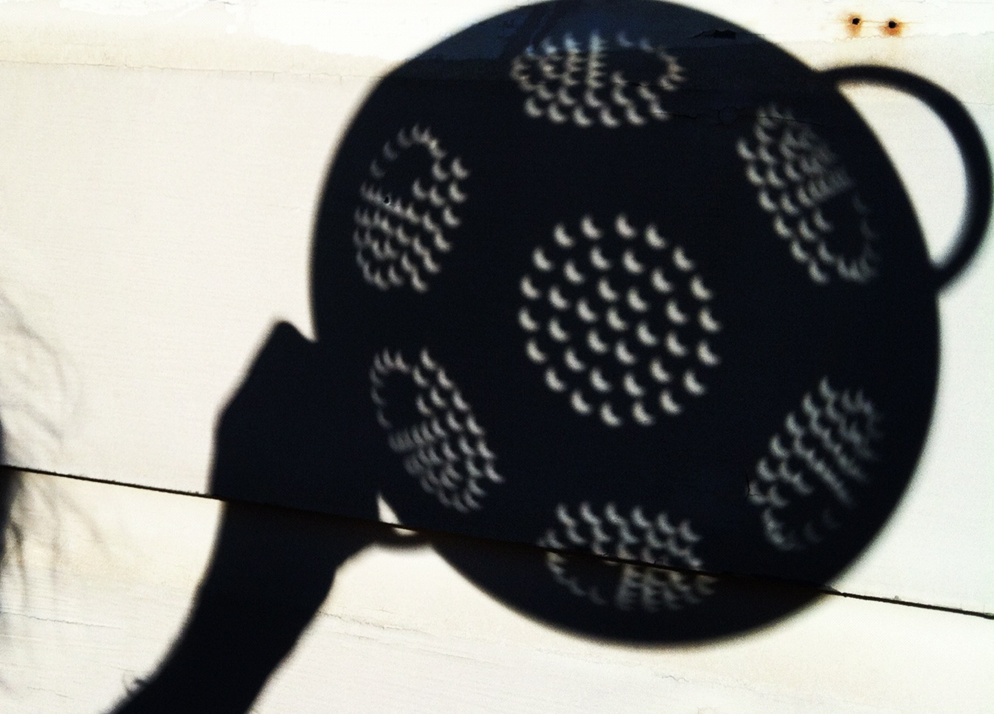
A step up is to take a piece of cardboard and make a clean pinhole in it. Stand with your back to the sun, and have the sunlight pass through the pinhole onto another card or onto the ground. You will also see a small image of the eclipsed sun:
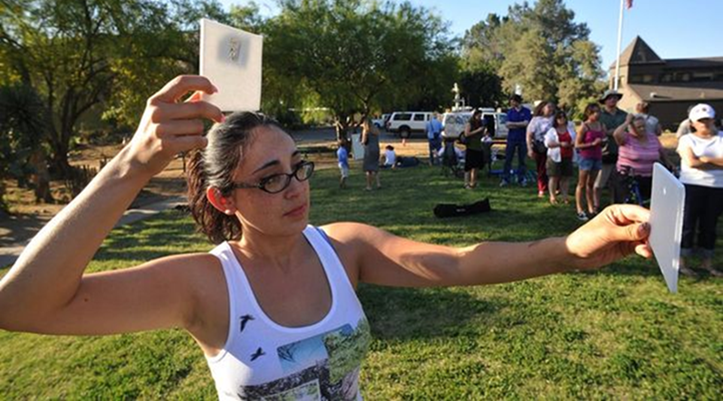
You can put a piece of tin foil in the card and poke the hole in the tin foil to get a cleaner hole.
Boxes can be used in a variety of ways to make a pinhole projector, from cereal boxes to larger containers. The longer the box, the larger the sun’s image.

A cereal box pinhole projector, schematic (above) and actual completed version (below)
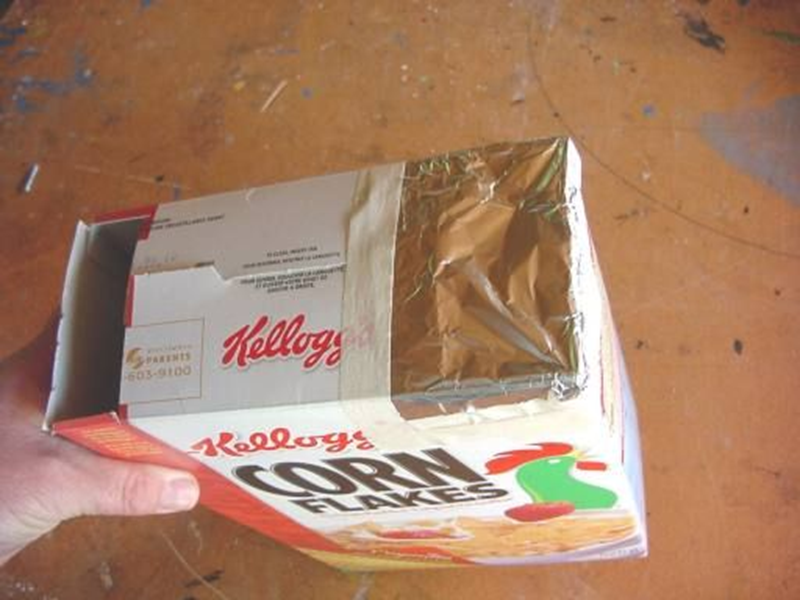

A schematic of an over-the-head pinhole projector system.
My favorite version is made from a poster tube. Take the cap off one end and cover with tin foil. Poke a small hole in the foil. This is the end you will point towards the sun. Leave the cap on the other end (to use as a screen) and cut a window in the tube near that end. You rest the tube on your shoulder with your back to the sun and you will see an image of the sun through the little window projected on the endcap screen.
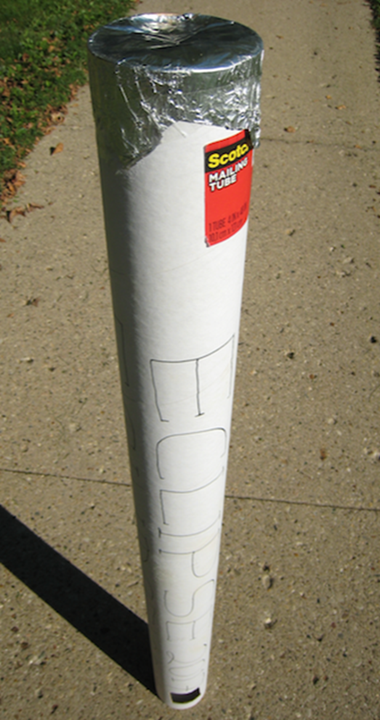
To align the tube with the sun, watch the shadow of the tube on the ground as you adjust it on your shoulder. When the shadow of the round tube looks perfectly round, you should see the sun appear inside the tube.

Rather than taking pictures of the sun directly, which requires a better filter than your eclipse glasses, take a picture of the projected image. Again, do not try to take pictures of the sun by putting your eclipse glasses on your camera! You can damage both your camera and your eyes.
In our last installment, we will discuss upcoming eclipses that you can see from the US.
Upcoming free public planetarium show

Note the date (a week later than usual because of the solar eclipse) and the later start time (due to daylight saving time).
Preparing for the April 8 Solar Eclipse, Nutmegger Edition, Part 2 – What to expect



Partial phases of a total solar eclipse, taken at the 2006 total eclipse in Egypt by Kris Larsen, using a special solar filter on a telescope. Do not try this at home!
Again, the April 8 eclipse will NOT be total anywhere in Connecticut. You will have to use safe observing techniques during the duration of the event (the subject of our next blog post). The sky will NOT turn dark, and we will not significantly note the weather changes and changes in animal behavior that accompany the total phase of an eclipse. Having said that, what will we see?

Times for Hartford, CT, courtesy of TimeandDate.com
The times given above are for Hartford – they are approximately correct for the entire state of Connecticut, within two minutes. The eclipse begins about 2:13 PM. You may not notice any changes through your eclipse glasses/pinhole projection device for the first minute or two – see when you can first notice a change!

About 15 minutes into the eclipse. Courtesy of TimeandDate.com
As the moon continues to cross the face of the sun, you will see more and more of the sun blocked, eventually turning the sun into an upside-down smile (or bright mustache). As more of the sun becomes eclipsed, take note of any changes you start to see in shadows – do you see the edges becoming sharper? It depends on the orientation of the crescent sun and the object creating the shadow, as described here. Experiment with it yourself!

About 45 minutes into the eclipse. Courtesy of TimeandDate.com
Another effect to look for is the tone of the sky’s color; while the sky won’t look darker, the texture of the blue can change in subtle ways once you get well into the partial phase. I usually describe the light as looking metallic. Again, the change may be subtle, so be a careful observer – practice those science skills!
Maximum eclipse – about 93% – will occur about 3:27 PM. Remember, you will still need to use safe observing techniques throughout the event in Connecticut!

Maximum eclipse (about 75 minutes into the eclipse). Courtesy of TimeandDate.com
Afterwards the process will reverse, until the eclipse ends about 4:37 PM.
If you would like to see an animation of what the eclipse will look like from Connecticut, see TimeandDate.com. Note that you can change the location to show the time and appearance for any other major city. In our next blog post, we will discuss safety!
— Kris Larsen
